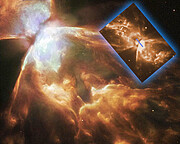First Measurement of Hyperfine Splitting Constant in an Astrophysical Object
28 April 2005
A joint Chile-United Kingdom team led by Simon Casassus (University of Chile) has used the NOAO-built Phoenix near-infrared spectrometer on Gemini South to obtain high-resolution spectra (R~75,000) of the [Al VI] 3.66-micron line region in the planetary nebula NGC 6302 (the Bug Nebula). By modeling the multi-component structure of the line, the team has been able to derive values for the electric quadrupole constant in the [Al VI] transition and measure a reliable isotopic ratio for aluminum. This is the first time such a constant in an atomic transition has been measured in any astrophysical object.
The isotopic ratio of Aluminum (Al-26/Al-27) is of astrophysical interest because it is a signpost of recent nucleosynthesis. Al-27 is the stable isotope, while Al-26 is radioactive – with a half-life of 720,000 years. Because the ratio is poorly established, the origin of Al-26 is currently assigned to a range of astrophysical processes ranging from nova detonations to cosmic-ray collisions in molecular clouds.
The Phoenix-targeted NGC 6302 is the highest excitation planetary nebula known. Its spectrum can be reproduced by ionization-bounded photoionization models that assume a 250,000 K central star. The photoionized coronal lines in NGC 6302 are astonishingly narrow, explained by a small expansion velocity. This and its rich spectrum make NGC 6302 an ideal object for the use of hyperfine structure as a diagnostic tool.
The derived isotopic ratio of Al-26/Al-27 is less than 1/33 in NGC 6302. This is the most stringent upper limit on the relative Al-26 abundance in any astrophysical object to date. Although the measurement is not constraining enough to quantify the Al-26 production in Asymptotic Giant Branch stars, which are the progenitors of planetary nebulae like NGC 6302, the technique is established. Tighter constraints require deeper spectroscopy of this planetary nebula, and extension of the analysis to other targets of low or moderate expansion velocity.
Hyperfine Spectroscopic Structure
Most observed spectral lines arise from electronic transitions between well-separated energy levels. However some transitions take place between very finely separated energy levels. A good example would be the hyperfine structure (HFS) lines due to interaction in the internal magnetic field produced by the motion of the electrons of an atom and the spin magnetic moment of its nucleus. This effect is well understood in terms of quantum mechanics. While hyperfine transitions are common in the radio range (the best known is the 21-centimeter line of neutral hydrogen), at shorter wavelengths atomic hyperfine structure has seldom been resolved in emission spectra because the velocity separation between hyperfine components is proportional to wavelength. Yet, ignoring the effect can result in errors of ~50% in the inferred photosphere elemental abundances.
More Information
More details can be found in the paper "Hyperfine splitting of [Al VI] 3.66-micron and the Al isotopic ratio in NGC 6302", by S. Casassus, P. J Storey, M. J. Barlow and P. F. Roche to appear in the Monthly Notices of the Royal Astronomical Society.



